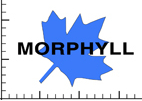How to search
General
In the MORPHYLL-database three different data types can be distinguished: metadata, taxonomic data and morphometric data:
(1) metadata comprise information of institutions, fossil site localisation, their stratigraphic position and specimen accession numbers
(2) taxonomic data (if existent) allow searches on species, genus, family and order level
(3) morphometric data include qualitative character states covering leaf margin, lobation, shape and size as well as venation types.
Quantitative morphometric data comprise leaf size, length, width length/width ratio and area index. If preserved petiole length and width are also provided.
To get full access to the complete set of data including morphometry
and high resolution images, please contact the curator of fossil plants
at SMNS (anita.rothnebelsick@smns-bw.de).
Please note the
Terms of Use.
Instructions
- Please enable Cookies: The underlying application relies on a session-cookie, which needs to be allowed for by your browser privacy settings.
Otherwise the multi-page result display cannot work, as result pages to your initial query are linked to each other by this cookie
- Capitalization: MORPYHLL-searches are case sensitive
- Wild cards: use "%" or "*", which specifies zero or more of any alphanumeric character; wild cards preceding or succeeding or
both. Example: "Linz%" finds "Linz-Pucking" and "Linz-Ebelsberg"
- Decimal place: point (#.#)
- All data fields can be combined arbitrarily; keep in mind that too many filters will possibly restrict the search to zero results
- A search field can be edited by double click in the input field and choosing an entry from the preselection list or
- A search field can be edited by typing the search term (case sensitive!)
- To display the corresponding data column in the result page check it on the right of the form (output - display data)
- Eventually press "Search"
How to interpret the number of matches of a query
Due to the goal of extracting morphometric data of the MORPHYLL-database an entity treated here is represented by a single leaflet.
Fossil leaves consisting of several leaflets (composed leaves) are split up to several entities - each of them is represented in the database by its own acccession number.
The quantity of matches of a query in the result page corresponds to entities (individual leaflets) and thus it is not necessarily reflecting the real number of fossil specimen.
Some queries will produce duplicated entries in the result page and consequently increase the number of matches.
The reason for this is the circumstance that descriptors of qualitative leaf traits are hierarchically structured.
For example the leaf margin type distinguishes untoothed and toothed leaves.
Toothed margins can be subdivided into in dentate, serrate and crenate margins.
In order to reproduce this hierarchical structure in the database a leaf can be characterised by several descriptors, e.g. toothed and dentate toothed.
Thus in unspecific queries i.e. in queries without filtering for a specific qualitative trait duplicated entries may occur.



